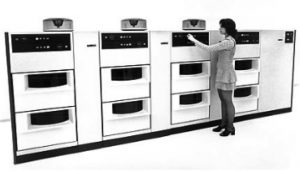History (1971): IBM 3330-1
First HDD with track following servo
This is a Press Release edited by StorageNewsletter.com on July 24, 2018 at 2:17 pmThis article comes from WikiFoundry, Inc.
1971: IBM 3330-1
1st track following servo

Why it’s important
Al Shugart in a 2000 interview identified track following servos as one of the four most significant events in the history of mass storage.
Track following, that is, positioning the heads based upon information recorded on the disk allowed tracks to be closer together (192 tracks per inch vs. prior art at 100 tracks per inch) thereby enabling increases in capacity. Ultimately, all HDDs adopted this technology (at about 600tpi) and extensions thereto.
The 3330 family of products as a part of the IBM System/370 was, in its time, believed to be the most successful product family in the history of commerce.
Discussion
The 3330-1 achieved 100MB via increasing both tracks per inch and the number of bits per track, and the 3330-11 version again doubled the tracks per inch to achieve 200MB.
Positioning the heads was based upon information recorded on the lowest disk surface, allowing tracks to be closer together than practical with mechanical detents thereby enabling increases in capacity.
Ultimately, all HDDs adopted this technology and subsequent variations. Track following was invented in 1958 by IBM’s Al Hoagland, see US patent 3,034,111. At 384 tracks per inch for the 3330-11 version, vertical alignment of 20 surfaces became more challenging for interchangeable removable disks, and subsequent development focused on drives featuring fixed head-disk combinations similar to those used today.
A performance improvement for the 3330-2 was obtained by physically orienting the acicular magnetic oxide particles in the circumferential direction before the wet coating was cured. This direction aligns the long axis of the physical particle between the pole tips of the recording head for maximum output and minimum noise. Particle orientation technology is conventional for magnetic tape, but this was the first application to a magnetic disk.
Glass bonding of ferite core to the ceramic head was a significant improvement over epoxy, since glass is far more rigid, plus mechanically and chemically stable. Glass bonding eliminated the pole tip movement issue inherent in the 2314 epoxy bonded design.
Servo control of the head array was by a ‘servo surface’ which was recorded with track position and circumferential timing information. This eliminated the need for mechanical detent positioning, and each disk pack became its own track location reference. Data capacity was limited to 19 recording surfaces, the 20th surface being a ‘read only’ surface for track positioning.
Rpm of the 3330 was increased to 3,600 (versus 2,400 for 2314), while the hydraulic actuator of 2314 was replaced by a voice coil unit, the net effect was reducing access time to 30 milliseconds, a 50% improvement.
Additional data is available at IBM’s web site. A few additional statistics follow:
Highlights
• First use of glass bonded ferite R/W transducer in a ceramic head
• First use of a track following servo-mechanism using a dedicated disk surface
• First use of MFM data encoding in a disk drive (more data efficient than FM of 2314)
• First use of oriented-particle media (3336-II) in a disk drive
• Controlled abrasive content in disk coating for improved durability
• HEPA filters used to control particulates to sizes below head flying height
Lowlights
• Higher tpi makes head alignment and spindle tilt more critical
• Head design is more sensitive to disk flatness due to lower flying height
• Disk flatness required thicker (0.100 inch), stiffer disk, new diamond turning process
• Cross-contamination unresolved ‘Typhoid Mary’ syndrome continues
• 3336 disk pack weighed 25 pounds, a potential handling difficulty
Additional information
IBM San Jose, A Quarter Century Of Innovation, David W. Kean, 1977, CHM accession number: 102687875
IBM Corporation’s 3330 Achive Web Site
Provenance note: This page was originally moderated by Mike Warner with input from a number of authors; his last approved revision was version 18.













 Subscribe to our free daily newsletter
Subscribe to our free daily newsletter

